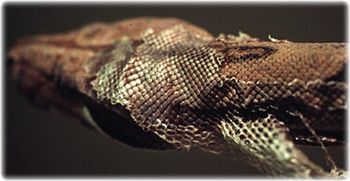Difference between revisions of "Snake Dysecdysis"
| Line 1: | Line 1: | ||
| + | {{OpenPagesTop}} | ||
==Introduction== | ==Introduction== | ||
[[Image:Boa_with_dys_ed.jpg|350px|thumb|right|'''Dysecdysis in Boa constrictor''' © RVC]] | [[Image:Boa_with_dys_ed.jpg|350px|thumb|right|'''Dysecdysis in Boa constrictor''' © RVC]] | ||
| Line 25: | Line 26: | ||
{{review}} | {{review}} | ||
| + | |||
| + | {{OpenPages}} | ||
| + | |||
[[Category:Snake_Skin_Diseases]] | [[Category:Snake_Skin_Diseases]] | ||
[[Category:Expert Review - Exotics]] | [[Category:Expert Review - Exotics]] | ||
Latest revision as of 18:32, 26 July 2012
Introduction
The entire skin is shed on a regular basis, often two to four times a year. The frequency depends upon the rapidity of growth, age, nutritional state, size and environmental factors.
Find out more about the funcion and morphology of Snake Skin . Find out more about normal shedding in snakes
Dysecdysis is improper or incomplete shedding. It may occur for various reasons including disease (mites, endocrinopathies, malnutrition, dermatitis or trauma) and problems of captivity (incorrect humidity, incorrect handling). Sometimes the spectacle fails to shed and remains as an opaque cover over the eye, restricting vision.
Treatment
Any snake with dysecdysis should be placed in a bath of tepid water for a minimum of 30 minutes and then placed between layers of dampened towels. As the animal crawls through the towel, this loosens and removes the soft epidermis. Additional treatment includes the application of contact lens solution on retained tertiary spectacles.
Prevention
A bath large enough for the snake to lie in should be placed in the cage. Sturdy rocks and logs should also be placed in the cage so the snake can start moulting by rubbing its chin on those structures.
Find out more information about helping to prevent dysecdysis using good husbandry.
| Snake Dysecdysis Learning Resources | |
|---|---|
 Test your knowledge using flashcard type questions |
Reptiles and Amphibians Q&A 14 |
References
Frye, FL & Williams, DL (1995) Self-Assessment Colour Review - Reptiles & Amphibians Manson
| This article has been peer reviewed but is awaiting expert review. If you would like to help with this, please see more information about expert reviewing. |
Error in widget FBRecommend: unable to write file /var/www/wikivet.net/extensions/Widgets/compiled_templates/wrt6621c28eab95b3_85687460 Error in widget google+: unable to write file /var/www/wikivet.net/extensions/Widgets/compiled_templates/wrt6621c28eb08843_00013266 Error in widget TwitterTweet: unable to write file /var/www/wikivet.net/extensions/Widgets/compiled_templates/wrt6621c28eb45946_54704794
|
| WikiVet® Introduction - Help WikiVet - Report a Problem |
